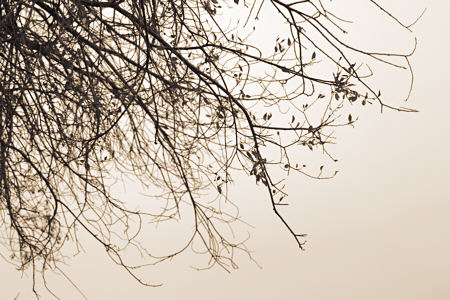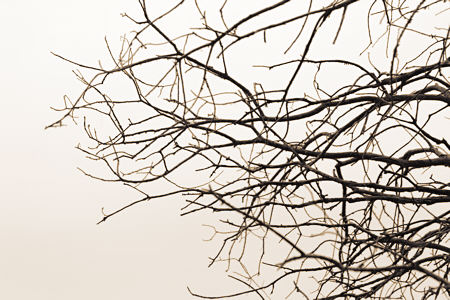
On a recent outing for another purpose, I found myself taken by the slender, skyward-reaching branches of the small trees I was among. I think it was the gray sky and the light drizzle that did it. It was a chill day, not unlike early spring, and I half remembered a William Carlos Williams poem which I’ve been unable to find. In searching, however, I came across The Botticellian Trees in Selected Poems, and the first part seemed to partially fit the subject:
The alphabet of
the treesis fading in the
song of the leavesthe crossing
bars of the thinletters that spelled
winterand the cold
[…]

Furthermore, the The Birth of Venus by Botticelli which came to mind has, in what I’ve always thought was the show-stealer—the nymph on the right bringing the cape for modesty—a better match for the spirit of curly Grace in those branches and twigs.

So here are more of the meetings of tree and sky I photographed. Do they seem forlorn to you? I admit to a certain wistfulness of the season, though I was thoroughly delighted to be out there.








Update: Click on the last image for a larger version.


Steve,
I love your filigree trees.
I vaguely remember you mentioning something about a picture format wider than 450 pixels. How wide was it? Using that wider format, would it significantly increase the memory load?
It would be great to see more detail with a wider picture.
These photos struck a chord with me. Your feelings about the branches and trees, and the special nature of the fall season reminded me of my favorite poem “The Snow Man” by Wallace Stevens.
One must have a mind of winter
To regard the frost and the boughs
Of the pine-trees crusted with snow;
And have been cold a long time
To behold the junipers shagged with ice,
The spruces rough in the distant glitter
Of the January sun; and not to think
Of any misery in the sound of the wind,
In the sound of a few leaves,
Which is the sound of the land
Full of the same wind
That is blowing in the same bare place
For the listener, who listens in the snow,
And, nothing himself, beholds
Nothing that is not there and the nothing that is.
The reddish hue remind me of the pinkish stem of trees in the winter on the Long Island North Shore.
Birgit,
I’m glad you enjoyed them. You can now see the last image in greater detail. It won’t fit within the A&P theme, but will appear by itself if you click.
Mike,
That’s a great poem, one of my favorites, and actually fits well with another series I’ve never shown, from ski trips up a local canyon that has a lot of spruce and fir. From personal experience, though, I think I come closer to that perceiving mind of winter when I’m well dressed for the day. If I’ve been cold for a long time my brain tends to fixate on hot cocoa–or just making it back to the car.
Birgit,
The branches and twigs were a warm reddish-brown, so straight black and white felt a little too cold. And in reference to the previous comment, I was plenty warm despite the chilly, damp day.
Steve:
And the twigs cover the bare expanse of the sky.
These photos trigger a number of memories for me. One takes me back to a time in my youth when I took briefly to the mountains as a deer hunter. One way to stalk was to sit and allow the deer to come to you. This required discerning the target from the underbrush in a three dimensional manner, as one scanned into the brush as well as side to side. To this day I tend to treat visual fields this way, picking out details at different depths. Just a memory and not so much a comment on your photos. Numbers four and six where a background is superimposed directly upon the foreground do not permit that kind of focusing in depth, but rather provide interesting superimpositions as sharply registered twigs and branches acquire halos and various ghost partners.
Steve,
Looking at the blow-up of the last image, is changing my view on in- and out-of-focus objects in pictures. The soft branches, while they not actually are, make me think of reflections.
Jay,
Your description echoes one way I’ve thought of some of my work like this, especially the Sourdough Trail series. Namely, I like to think that the close-up views, with parts in focus and parts out of focus, are like what a squirrel or bird or other critter in the woods might see, peeping from a branch, perhaps. There is, I hope, the sense that these are momentary perceptions, and the next moment might bring another context or another focus of attention.
Birgit,
Reflections–that’s a lovely thought. I tend to think of them more as layers, but reflections are nice because they’re somehow a comment specifically directed back on another subject (e.g. the branches in focus). Here they’re sort of a reminder that there’s more in the environment beyond the main subject.
Steve:
Don Juan wanted Carlos to scan his environment, constantly moving his attention and touching lightly on its details. A real font of knowledge that Don Juan.
We’re talking too about a way of driving, where one picks out the most distant relevant elements in one’s field of view and, using that as an anchor, the driver makes a construction of everything between that anchor and himself. It’s not so much a matter of observing that field in detail, but rather of assigning a kind of priority to it. I don’t know if Montana deer tend to jump out on the road, but they will and do around here with potentially disastrous results for all concerned. One can often spot them well up the road if one has turned to “deer” on the attention dial.
An idea: you know those frames that will display a sequence of images? Quite the thing around the holidays? Have the sequence be a single point of view with differential focusing. Not as easy as it sounds, I know. But things can be thrown in and out of focus on the computer.
Jay,
I like the sequence idea, may have to steal it. If I had the time (and patience), I’d keep the camera in one place all day.
The deer are also plentiful here, and just as dumb. A couple days ago, the one I was watching ahead of me chose to run across just in front of an oncoming truck. I’ve had some fairly close calls, but no collisions yet. We also have cattle and a few moose to worry about, and those Angus are black.
I’m wondering if accidents are more likely in familiar or unfamiliar territory. And if we see more in a picture of a familiar or unfamiliar subject.
Steve:
The itinerant herds wandering the suburbs fear most the civic authorities. Bedford, if I remember, had to cull a couple of hundred deer the other year. There’s a certain what-me-worry? quality about the ones I see. They have very little to fear as long as they stay away from major streets as local animal wardens deal with stray dogs. Fecundity and rapid maturation trump thinking as the chosen survival strategy.
More and less. If I’m driving down a back-of-my-hand road I might be responding to a template that is composed of what I know and what I experiencing at the time. Sometimes what I remember will trump what I am experiencing – one reason why careful managers will put up signs informing traffic of any changes in lights at intersections etc. An again, it might be a matter of where,and on what your attention is drawn. That’s a huge question.
A friend has started a new project here:
http://www.talkshow247.com/
I am pretty sure that I mentioned Marc to this group. I have always enjoyed his photographs.